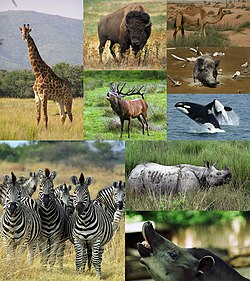| Pan-Euungulata Temporal range: Late Cretaceous to present | |
|---|---|
 | |
| Members of mirorder Euungulata | |
 | |
| Lower jaw of Protungulatum donnae | |
| Scientific classification | |
| Domain: | Eukaryota |
| Kingdom: | Animalia |
| Phylum: | Chordata |
| Class: | Mammalia |
| Grandorder: | Ferungulata |
| Clade: | Pan-Euungulata O'Leary, 2013 [2] |
| Subgroups | |
| |
Pan-Euungulata (literally: "all true ungulates"; also known as: Euungulata [sensu lato] [3] ) is a clade of placental mammals from grandorder Ferungulata, consisting of the taxon Euungulata [sensu stricto] and all taxa (species) more closely related to it than to any other living species. [2]
Contents
The specification of the above-mentioned taxa related to Euungulata s.s. varies from author to author and changes over time. [2] [4] [5] [6] The extinct family Protungulatidae is a typical representative of such taxa. [3] [7]
Some (usually older) texts use the conceptually similar clade Ungulata in the broadest sense (and/or the clade Ungulatomorpha, which is Ungulata in the broadest sense plus Zhelestidae). This clade differs from Pan-Euungulata in that it also includes the taxon Paenungulata (i.e. for example Proboscidea, Sirenia and Hyracoidea) and sometimes also the taxa Tubulidentata and Dinocerata (and in the case of Ungulatomorpha also the taxon Zhelestidae). [8] [9] [10]
